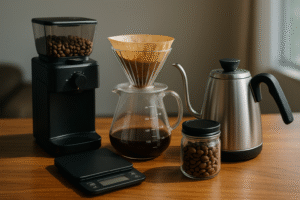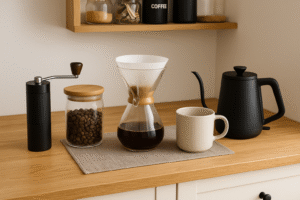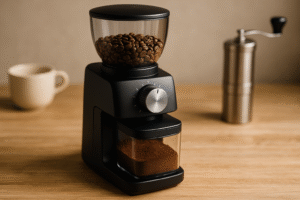For many coffee lovers, bringing the espresso experience home is the ultimate goal. But choosing the right espresso machine can be overwhelming.
With so many options on the market, it’s easy to get lost in features, price points, and technical specs.
The good news is you don’t need to be a professional barista to make great espresso at home. With the right machine for your skill level and lifestyle, you can enjoy café-quality coffee without leaving your kitchen.
This guide will walk you through the key factors to consider when buying a home espresso machine.
Understand Your Espresso Goals
Before diving into models and features, ask yourself a few questions:
- Do you want push-button convenience or hands-on control?
- How often do you drink espresso?
- Are you making drinks for one person or multiple?
- Do you prefer straight espresso, or milk-based drinks like lattes and cappuccinos?
Your answers will guide the type of machine that suits you best—manual, semi-automatic, automatic, or super-automatic.
Types of Home Espresso Machines
There are four main types of espresso machines, each with different levels of involvement and control.
1. Manual Machines
Also known as lever machines, they require full control over the process. You grind, dose, tamp, and pull the shot by hand.
They’re beautiful and offer unmatched control, but have a steep learning curve. Best for enthusiasts and purists.
2. Semi-Automatic Machines
The most popular category for home use. You grind and tamp the coffee, then start and stop the shot manually.
They strike a balance between control and consistency. Ideal for hobbyists who enjoy the ritual of espresso-making.
3. Automatic Machines
Similar to semi-automatics, but they stop the shot automatically. You still grind and tamp, but don’t have to worry about timing.
Great for people who want a hands-on experience without needing to measure extraction manually.
4. Super-Automatic Machines
Fully automated—grinding, dosing, tamping, brewing, and even steaming milk with the touch of a button.
Perfect for convenience lovers, busy mornings, or homes with multiple coffee drinkers. However, they offer limited control and customization.
Budget Breakdown
Espresso machines range from under $200 to well over $3000. Your budget determines not only the type of machine, but also its build quality, durability, and espresso quality.
Entry Level ($200–$500):
Expect basic semi-automatic models with built-in pressurized baskets and limited temperature control.
Great for beginners, but less room for growth or precision.
Mid-Range ($500–$1000):
Offers better pressure consistency, temperature stability, and steam power. Ideal for home baristas ready to develop their skills.
High-End ($1000+):
Built for performance, reliability, and control. These machines feature PID temperature control, powerful boilers, and pro-level components.
They allow experimentation and are designed to last years with proper care.
Boiler Types and Their Impact
Espresso machines use boilers to heat water. The type of boiler affects heat-up time, temperature control, and milk steaming.
Single Boiler:
You can brew espresso or steam milk, but not at the same time. More affordable, but requires waiting between tasks.
Heat Exchange (HX):
Allows simultaneous brewing and steaming. Water for brewing is heated indirectly through a heat exchanger.
Dual Boiler:
Two separate boilers provide precise temperature control for both tasks. Ideal for serious espresso enthusiasts or high-volume use.
Temperature and Pressure Stability
Consistent temperature and pressure are essential for good espresso.
Look for machines with PID controllers (digital thermostats) to maintain steady temperatures.
Pump pressure should reach 9 bars for optimal extraction. Some machines exceed this, but anything too high can over-extract the coffee.
Pressure profiling is an advanced feature that allows custom pressure curves, but it’s not necessary for most users.
Grinder: The Unsung Hero
Your espresso is only as good as your grinder. Investing in a quality burr grinder is just as important as the machine itself.
Some super-automatics include grinders, but for other machines, you’ll need a separate one.
Look for grinders that can produce fine, consistent grounds with micro-adjustments for dialing in shots.
Plan to spend at least $200 on a good espresso grinder for consistent results.
Steam Wand and Milk Frothing
If you love lattes or cappuccinos, the steam wand is critical.
Basic machines may have panarello wands, which are easier for beginners but offer less control.
High-end machines come with commercial-style steam wands that create silky microfoam with proper technique.
Some super-automatic machines use built-in milk frothing systems, which are convenient but harder to clean and less precise.
Size and Aesthetic
Counter space matters. Espresso machines range from compact single-boiler units to large dual-boiler setups.
Measure your space and consider height (especially under cabinets). Don’t forget room for a grinder, scale, tamper, and accessories.
Design matters too. Many machines come in stainless steel, matte black, or vintage finishes. Choose one that complements your kitchen and reflects your style.
Ease of Use and Cleaning
Consider how much time you’re willing to spend cleaning and maintaining your machine.
Machines with removable drip trays, accessible brew groups, and descaling alerts make life easier.
Super-automatics often have auto-cleaning cycles, but some parts may be harder to access for deep cleaning.
Semi-automatics require manual rinsing and descaling but are easier to maintain long-term.
Recommended Models by Category
Beginner-Friendly:
- De’Longhi Dedica
- Breville Bambino Plus
- Gaggia Classic Pro
Mid-Range Prosumer:
- Rancilio Silvia
- Lelit Mara X
- Profitec Go
Super-Automatic Convenience:
- Jura E8
- Philips 3200 Series
- Breville Oracle Touch
Each has strengths depending on your goals, so choose based on your preferences and how much control you want.
Accessories to Pair With Your Machine
To get the most from your espresso setup, consider a few extras:
- Precision tamper and distribution tool
- Espresso scale with timer
- Knock box for used grounds
- Milk pitcher for frothing
- Shot glasses for dialing in
These tools enhance consistency and make your routine smoother and more enjoyable.
Conclusion: Your Perfect Machine Is the One That Fits You
There’s no single “best” espresso machine—only the best one for your lifestyle, taste, and experience level.
Whether you want hands-on control or push-button ease, there’s a machine out there that fits your needs.
Start with clear goals, match your budget, and invest in quality gear. Then enjoy the satisfaction of crafting the perfect shot at home.

Marcio Luzardo is a coffee enthusiast and the voice behind Tudo Viraliza. With a passion for turning curiosity into practical knowledge, he shares easy-to-follow tips, guides, and insights to help readers enjoy better coffee every day. When he’s not writing, Marcio is exploring new brewing methods or diving into the rich stories that connect coffee to culture, lifestyle, and wellness.



